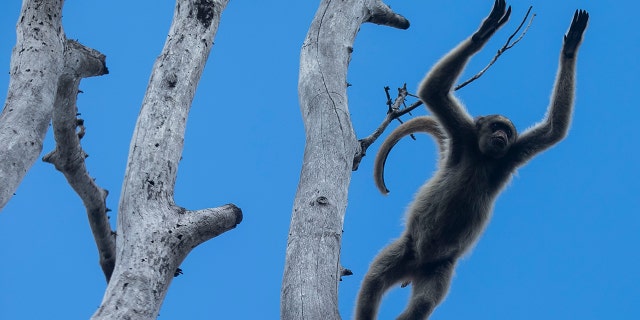The emerald-green canopy shifts and rustles as a troop of willowy, golden-gray monkeys slides through a tropical ecosystem more threatened than the Amazon.
Karen Strier started studying the biggest monkey in the Americas four decades ago, when there were just 50 of the animals left in this swath of the Atlantic forest, in southeastern Brazil’s Minas Gerais state.
Strier immediately fell in love with the northern muriqui, dedicating her life to saving it and launching one of the world’s longest-running primate studies.
“I love everything about them; they’re beautiful animals, they’re graceful, they even smell good, like cinnamon,” the American primatologist told The Associated Press on a recent field trip. “It was a complete and total sensory experience that appealed to my mind as a scientist, and to my mind as a person.”
Research was focusing on primates from Africa and Asia, where dominant males frequently fought one another to impose or maintain their power in highly hierarchical societies. Strier herself had spent six months studying baboons in Kenya.
“Muriquis are at the far other extreme of peacefulness,” she said.
In 1983, her first year of research, the biologist spent 14 months in the rainforest observing muriquis. This slender vegetarian can measure up to 5 feet from head to tail, and weigh up to 33 pounds. While muriquis can live as long as 45 years, females can only give birth every three years, slowing down efforts to repopulate the species.
Gender roles among muriquis also were unusual among large primates, Strier’s initial research found. Much like bonobos, muriqui females are the same size as males, meaning they have a lot of autonomy, and in muriqui societies, females break off from the group to seek partners.
“We now see a lot more variations among primates, and I think the muriquis helped open that door to understanding better some of this diversity,” Strier said.

A northern muriqui monkey jumps from a tree at the Feliciano Miguel Abdala Natural Heritage Private Reserve in Caratinga, Brazil, on June 14, 2023. (AP Photo/Bruna Prado)
Inside the 2,300-acre Feliciano Miguel Abdala reserve, a privately protected area where Strier has based her research program, the northern muriqui population has grown nearly fivefold, to 232. That’s about one-fifth of the critically endangered species’ overall population.
After drought and a yellow fever outbreak killed 100 muriquis — about a third of the reserve’s population — in just five years, Strier has strongly advocated for the creation of forest corridors and supporting species reintroduction projects.
In 2016, Fernanda Pedreira Tabacow, a former student and right arm of Strier’s, heard that there were only two muriqui males left in a patch of forest in Ibitipoca, southwest of the Feliciano Miguel Abdala reserve. She knew that, without any intervention, they were doomed.
“I thought that was the last breath of the species here,” Tabacow said.
CLICK HERE TO GET THE FOX NEWS APP
Earlier this month, primatologists, environmentalists and other muriqui enthusiasts from Brazil and abroad converged on the small city of Caratinga to celebrate Strier’s 40th year of uninterrupted study. She started by thanking peers and the many students who are carrying forward her work.
She also used her stage to advocate for the creation of a forest corridor linking the Feliciano Miguel Abdala reserve to another area 25 miles away, urging the Environment Ministry representative to follow suit. Underscoring the need for the northern muriqui to have a greater range, she spoke of the “terrifying” yellow fever outbreak several years back.

